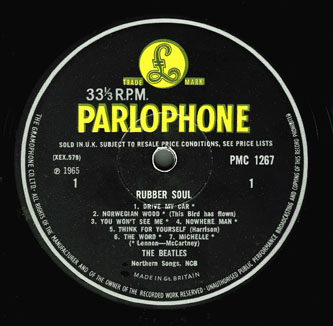DECIPHERING BEATLES STAMPERS
I’ve had some inquiries on how to decipher the small markings in the vinyl next to the label on UK Beatles LPs. You can deduce the numbering system for early EMI pressings by looking at the label and going to 6 o’clock in the dead wax (run off groove) area of the vinyl. The following holds true for all records pressed by EMI during the 60’s and 70’s. What’s called a lacquer number can be found to the right of the matrix number, which is an indication of the particular album title, side, and whether it is mono or stereo. For example, on Side One of a first pressing mono Rubber Soul LP, there is the machine stamped matrix number XEX 579 followed by the lacquer number –1, which means this LP originated from the 1st lacquer made using the mono master tape with this matrix number (stereo is YEX). At 9 o’clock is the metal mother number which on my LP is 3, indicating that this pressing came from the 3rd metal mother made via a metal master from that lacquer. At 3 o’clock is the code for which particular metal stamper actually produced this pressing (stampers are made from mothers). For UK EMI, the stamper coding works like this: G R A M O P H L T D (Gramophone Ltd), where G=1, R=2, A=3, M=4, O=5, P=6, H=7, L=8, T=9, and D=0. In my example, the stamper code on the pressing is GP. This means that this LP was pressed from the 16th stamper of the 3rd mother of the 1st lacquer. The lower the lacquer number on an LP, the earlier it was made. A common assumption is that the earlier a record is made, the better it should sound. However, this is not always the case as stampers do wear out and other anomalies can occur. It’s all part of the wonderful world of vinyl.

